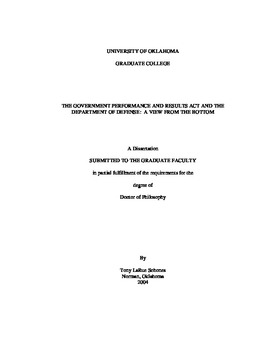| dc.contributor.advisor | James, Thomas E., | en_US |
| dc.contributor.author | Schones, Tony Larue. | en_US |
| dc.date.accessioned | 2013-08-16T12:19:26Z | |
| dc.date.available | 2013-08-16T12:19:26Z | |
| dc.date.issued | 2004 | en_US |
| dc.identifier.uri | https://hdl.handle.net/11244/744 | |
| dc.description.abstract | At least five government-wide reform initiatives have been attempted since the end of World War II. The latest is the Government Performance and Results Act (GPRA) passed into law in 1993. A review of literature on government budgeting contends that previous initiatives failed to achieve their stated objectives primarily because they did not alter the inherently political nature of decision-making in the federal budget process. Less than five years later and despite efforts to overcome many of the weaknesses of previous initiatives, critics of the GPRA began to sound a familiar theme---the GPRA was failing because it had not fundamentally altered the politics of the federal budget process. | en_US |
| dc.description.abstract | I found all of the factors did influence the implementation of the twelve selected initiatives to some degree. Only one factor, however, was significantly important to every initiative---focus. Correctly identifying what is expected to change is not only important to reform success in and of itself but it also impacts the other factors. I concluded that the objectives for changes in the internal operations of the Executive Branch agencies outlined in the GPRA are being achieved in the Department of Defense (DoD). I also found that these changes may be influencing, albeit indirectly, final budgetary decision-making by providing more accurate information to top-level decision-makers in the federal budget process. | en_US |
| dc.description.abstract | Traditionally, research in the area of reform efforts aimed at improving performance in the federal government has focused more on the top levels of government, i.e., budget interaction of the president and the Office of Management and Budget (OMB), top agency officials, and congressional budgeters. As a result, findings have been less than promising. | en_US |
| dc.description.abstract | If you look for changes only at the top levels of government, the critics are not wrong---the GPRA has achieved no more success in altering the politics associated with federal budgeting than its predecessors. There is, however, another perspective from which to evaluate government reform---from inside an agency at the bottom of the bureaucratic pyramid, i.e., the managerial and operating levels of the Executive Branch agencies. This research began with a single question: How does our evaluation of reform change when viewed from inside an agency? To answer the question, I conducted a case study of 12 reform initiatives at the Oklahoma City Air Logistics Center and the Air Force Materiel Command from 1995 until 2003. After the GPRA was signed, agencies focused on improving their internal processes used to identify and assess future needs and the accuracy of their future budget requests. Therefore, if evaluators look for changes in how the president works with OMB or the politics practiced by congressional budgeters, no major effects are likely to be found and the reform effort will be labeled a failure. But, based on the findings of this research, if you evaluate the reform initiative based on changes in the day-to-day activities of an agency at the operational levels, it is probable that you will find far more success than failure. | en_US |
| dc.description.abstract | The guiding framework for this research was seven factors generally accepted as critical to the success or failure of reform initiatives: (1) impetus; (2) focus; (3) decision-making; (4) key actors; (5) accountability; (6) knowledge and information; and (7) time. The twelve reform initiatives included in the case study were evaluated according to these factors. | en_US |
| dc.format.extent | xi, 232 leaves ; | en_US |
| dc.subject | Oklahoma City Air Logistics Center Appropriations and expenditures. | en_US |
| dc.subject | Political Science, Public Administration. | en_US |
| dc.subject | Political Science, General. | en_US |
| dc.subject | Oklahoma City Air Logistics Center Management. | en_US |
| dc.subject | Economics, Finance. | en_US |
| dc.subject | United States Armed Forces Appropriations and expenditures Case studies. | en_US |
| dc.subject | United States. Air Force Materiel Command Appropriations and expenditures. | en_US |
| dc.subject | Government productivity United States Case studies. | en_US |
| dc.subject | United States. Air Force Materiel Command Management. | en_US |
| dc.subject | United States. Government Performance and Results Act of 1993. | en_US |
| dc.title | The Government Performance and Results Act and the Department of Defense: A view from the bottom. | en_US |
| dc.type | Thesis | en_US |
| dc.thesis.degree | Ph.D. | en_US |
| dc.thesis.degreeDiscipline | Department of Political Science | en_US |
| dc.note | Adviser: Thomas E. James. | en_US |
| dc.note | Source: Dissertation Abstracts International, Volume: 65-05, Section: A, page: 1959. | en_US |
| ou.identifier | (UMI)AAI3132282 | en_US |
| ou.group | College of Arts and Sciences::Department of Political Science | |
